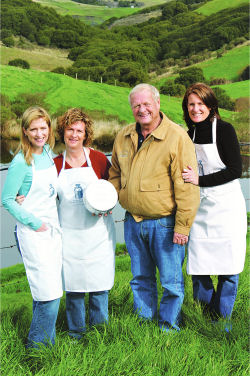Rhapsody in Blue
Coastal family reunites to make farmstead cheese
May/June 2006
By Jim Morris, California Farm Bureau Federation
Holsteins meander atop the fog-enshrouded hills overlooking Tomales Bay, though the pace is decidedly faster inside a nondescript metal building just around the bend.

But the cheese provides more than just gourmet goodness. It's a bridge of sorts, reuniting this fourth-generation California farm family.
"It's something everybody wishes for in life," said patriarch Bob Giacomini. "We've been lucky enough to have three of our four kids come back to the farm and get involved in my life's work. Now we have eight grandkids, and hopefully two or three of them will carry on the tradition long after I'm gone."
With a firm handshake and even firmer convictions, Giacomini looks the part of a dairy farmer. His passion for maintaining a herd of happy cows and producing quality milk is surpassed only by his love for family.
"That means pretty much everything to us," he said. "The older you get, the more you appreciate family. It's what makes life worth living."
Giacomini's daughters Jill Basch, Karen Howard and Lynn Stray had all left the farm, married, had children and established big-city careers. But in developing the farmstead cheese business, all three returned to serve as managing partners. The fourth daughter, Diana Hagan, lives in the Bay Area, yet serves as a shareholder in and financial advisor to the company.
After years as urbanites, the sibling trio faced the dramatic lifestyle change of coming back to country living.
"It was a huge culture shock," Basch said. "I was in the Silicon Valley during the dot-com boom and actually retired that career during the bust. Being in the Silicon Valley when a lot of people's stock options were going down the drain was very stressful. I also don't miss the commute. It's much nicer to come to the country every day where people are much more open minded and welcoming into the community."
Basch's sister said she assumed that life on the farm was a chapter in her past, never to be relived.
"I was never, ever anticipating coming back to Point Reyes," Stray said. "Coming home to a small town and getting involved has been a great reward and a great place to raise kids."
Howard added, "We've always been a close family and share a love of food. One thing that makes me want to come to work every day is knowing I'll be with my sisters and my dad. If you're having a bad day, everybody forgives you and you move on. It's just a great atmosphere. You can be yourself at all times."
Giacomini has operated the dairy since 1959, maintaining a herd of 300 on 700 acres. As he grew closer to retirement age, he and his wife, Dean, sought a way to diversify the business and coax their daughters back to the farm. After a year and a half of research, the answer became clear: produce and market a high-quality blue cheese.
Point Reyes Original Blue was launched in 2000 and has been a hit in the marketplace ever since. The farm produced 350,000 pounds of cheese last year, with annual growth expected to continue at more than 20 percent.
While Giacomini oversees the dairy--managed by herdsman Paul Zimmerman--and his daughters take care of sales and marketing, cheese making is the responsibility of Monte McIntyre, a Midwest transplant credited with making consistently high-quality cheese. McIntyre grew up on a farm in South Dakota and had worked as manager of the critically acclaimed Maytag Cheese Co. in Iowa.
Like winemaking, producing cheese is a blend of art, science and labor. As a result, each batch is as unique as a fingerprint.
Cheese making at the Giacomini family's operation begins with raw milk piped into 1,500-gallon vats from the dairy just 50 yards away. Milk and butterfat are separated, so that the butterfat can be homogenized to yield a creamier cheese and a faster rate of aging. The milk and butterfat are then rejoined, with cultures and mold added. The mold the family uses is the French import Penicillium Roqueforti, specially selected for its pungency but also to balance the sweetness of the milk.
The next step is to add rennet, a coagulant used for thickening. Then curds are cut and the liquid, or whey, is released. These curds are transferred to plastic forms in a process known as hooping. The curds spend the night inverted and are then taken to the curing room, where kosher salt is added daily for three days. Holes are punched into the cheese to create air passages and allow the flavorful blue veins to grow.
After the swift pace early in production, a new skill is now required: patience. The cheese sits in a curing room for three weeks, then is placed in Cryovac bags to mature for four to five months in an aging room. All told, it takes half a year before the cheese is ready to be packaged and shipped.
Point Reyes Original Blue is sold online (www.pointreyescheese.com) and is available nationwide at specialty food stores and supermarkets such as Whole Foods. Restaurants including the nearby Olema Inn, San Francisco's acclaimed Gary Danko, Clyde's in Washington, D.C., Cool River in Dallas and Mama's Fish House in Maui have it as a prominent feature. It's also the official blue cheese of the Culinary Institute of America in Hyde Park, N.Y.
The most popular use of this cheese is to sprinkle it on salads, though the family has published a cookbook with many creative ways to enjoy it--from pairing it with fresh asparagus to livening up a grilled cheese sandwich. Their cheese has been used in stuffed martini olives, ravioli and pizza and even blended in ice cream.
With its bluish veins winding through a chalk-white background, Point Reyes Original Blue can be part of a dramatic presentation--though its showy appearance belies its easiness on the palate. The rich, creamy cheese with notes of buttermilk is a natural paired with grapes, a baguette and a full-bodied wine such as petite syrah. It's always at its flavorful best when allowed to warm to room temperature.
The Giacomini family said they foresee the demand for their cheese to remain as promising as the deep blue sky and lush green pastures that surround their farm.
"We've been riding the wave of American cheeses and their popularity in the last five to seven years," Stray said. "The fact that there are a lot more of us small, artisanal cheese makers--we're really getting noticed by food writers."
As their cheese gains popularity, family members said this foreshadows their most important goal: staying together and maintaining their heritage.
"It's about carrying on a tradition," Stray said. "Knowing that we truly love what we do has made it all worthwhile."
"We're hoping to build a legacy here," Howard said. "This was a dream that we had. It's a way for our family farm to keep thriving and feeding people in America."
Jim Morris is a reporter for the California Farm Bureau Federation and host of the popular weekly television program "California Country." He can be reached at 800-698-FARM or jmorris



